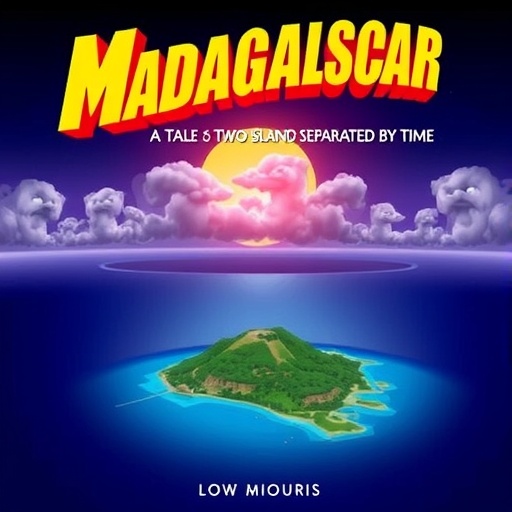Madagascar’s geological past is a chronicle etched into the very fabric of its landscape, revealing a history far more complex than previously understood. Far from being the product of a single tectonic event, the island’s dramatic topography owes its existence to two distinct rifting episodes separated by nearly 80 million years. This nuanced understanding, unveiled through state-of-the-art computational simulations, sheds new light on how ancient tectonic forces have not only shaped the island’s physical features but also its unique biodiversity.
The first major tectonic episode occurred approximately 170 million years ago, marking Madagascar’s initial separation from the African continent. This rifting process created a rugged escarpment on the western edge of the island and resulted in an eastward-tilted plateau. During this prolonged geological phase, for tens of millions of years, the island’s river systems were largely stable, draining predominantly eastward across this plateau and carving the landscape in accordance with the initial tilt.
A second, less recognized but equally transformative rifting event followed around 90 million years ago, this time on Madagascar’s eastern margin. This event vector was notably different; it resulted in the island tipping in the opposite direction—westward. This re-tilting caused a dramatic reorganization of the landscape, including a reversal in river flow, a shift of the island’s primary hydrological divide, and the emergence of a steep escarpment facing the Indian Ocean, which remains one of Madagascar’s most iconic geological features today.
The mechanism behind these large-scale changes lies in the island’s water divide—the crucial boundary determining whether river flows head east or west. Each tectonic tilt effectively relocated this divide, forcing rivers to abandon their long-established courses and erode new channels aligned with altered slopes. Such profound hydrological and erosional shifts rewrote the island’s geomorphological narrative, carving new valleys and plateaus while wearing down old escarpments.
Over geological time, the landscape evolution has produced a dichotomy within Madagascar’s topography. The western escarpment, once sharp and steep, gradually transformed into a series of worn-down highlands and low-relief plateaus. Contrastingly, the eastern escarpment is markedly younger and more linear, characterized by steep, cliff-like features. This juxtaposition illustrates how varying tectonic timings and rates of erosion have forged diverse terrains within a relatively confined area.
Beyond its geological fascination, this story of Madagascar’s landscape evolution carries significant implications for understanding the island’s exceptional biodiversity. Madagascar’s biological wealth is staggering: over 90% of its mammalian and reptilian species and more than 80% of its plant species are endemic, found nowhere else on Earth. While previous explanations focused on climate and prolonged isolation, newer research points to landscape dynamics as a pivotal driver in creating environments conducive to speciation and evolutionary divergence.
This geological perspective suggests that the migration and reconfiguration of water divides acted as a “speciation pump.” By repeatedly fragmenting habitats and altering migration pathways, the tectonic-driven shifts forced populations of flora and fauna into isolated pockets, encouraging genetic divergence and the emergence of new species. The dramatic and uneven topography, particularly along the dynamic eastern escarpment, became a crucible of evolutionary novelty.
The pioneering work led by Romano Clementucci at ETH Zurich leverages computational modeling to unravel these complex tectonic and erosional histories. By simulating the island’s lithospheric responses to successive rifting events, the study provides a detailed temporal map of how river networks and mountainous divides migrated across the landscape. Such models underscore the intricate interplay between geological forces and biological processes.
This study also resurrects the visionary ideas of Alexander von Humboldt, who in the 19th century advocated a holistic approach to biodiversity that integrated geological and climatic factors. The new findings substantiate Humboldt’s early insights by extending contemporary biodiversity theories beyond climate corridors and isolation mechanisms to include dynamic erosion processes and geomorphological evolution.
Moreover, this research challenges the perception of so-called stable continental margins—regions like Madagascar, South Africa, India, Brazil, and Australia—traditionally viewed as geomorphologically static. Instead, these passive margins exhibit ongoing and profound internal dynamics that sculpt their surface environments. Such subtle yet persistent geological transformations leave indelible marks on the distribution and evolution of life.
In a broader context, this paradigm shift calls for a revised framework in understanding biodiversity hotspots globally. Recognizing geological evolution as a critical factor invites interdisciplinary collaboration between earth scientists and biologists. It encourages exploration of how ancient geomorphic processes continue to shape habitat fragmentation, migration routes, and ultimately the speciation processes that drive biological diversity.
Madagascar emerges from this lens not merely as an isolated “island of life,” but as an active geological theatre, where the interplay of tectonic tilts, river reorganizations, and erosion patterns has forged one of the planet’s richest biodiversity refuges. The legacy of these ancient rifts is thus both a geographical and biological narrative, a testament to how Earth’s dynamic crust molds evolutionary pathways over millions of years.
Future studies will likely build on these computational models, integrating paleoclimatic data and fossil records to more precisely map when and how species diverged in response to geological transformations. Such research promises to deepen our understanding of the feedback loops between Earth’s physical changes and the evolutionary trajectories of its inhabitants, illuminating not only the past but potential futures of biodiversity amidst ongoing geological activity.
This study, funded by the Swiss National Science Foundation, stands as a milestone in geobiological research, uniting tectonics, geomorphology, and evolutionary biology in a compelling story of Madagascar’s past. As new technologies refine our view of Earth processes, the dynamic history of landscapes like Madagascar will continue to offer unparalleled insights into the origins and maintenance of life’s spectacular diversity.
Subject of Research: Not applicable
Article Title: Madagascar’s landscape evolution: A tale of two rifts
News Publication Date: 15-Oct-2025
Web References: 10.1126/sciadv.adw6362
Image Credits: Sean Willett / ETH Zurich
Keywords: Madagascar, landscape evolution, tectonics, rifting events, river reorganization, biodiversity, speciation, erosion, computational modeling, eastern escarpment, passive margins, geobiology




